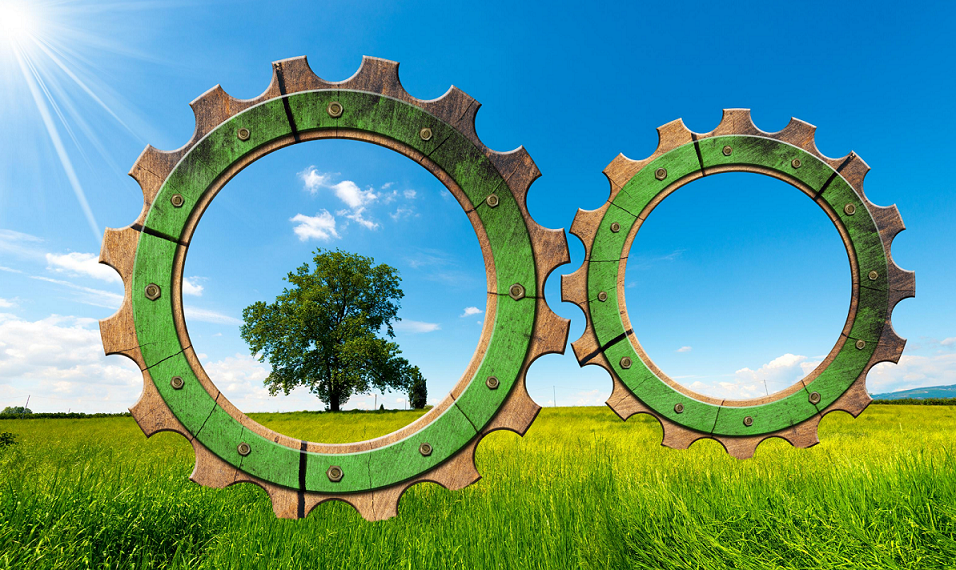In 2015 at the University of Louisville, Justin Mog, the assistant provost for sustainability initiatives, gave a Tedx Talk entitled “The Myth of Environmental Sustainability.” His speech focused on the environmental implications of human behavior, and he focused on what taking steps towards true sustainability should actually look like.

“Basically since the late 60s or so, we as a species have been living far beyond our means” Mog said. “It is as though we were adolescents in the 60s and somebody gave us a credit card and we started maxing it out with no ability to pay it back. Unfortunately, who we owe isn’t Bank of America. It’s ourselves and it’s our common future.”
Here, Mog is chiefly referring to the increase in CO2 levels into the Earth’s atmosphere as economic growth in many countries continued to climb, which was financed by fossil-fuels and which squashed attempts for environmental conservation. Obviously, the world has changed since the 60s, and more sustainable energy sources have been created. But that bids the question: Is it possible for a country or city to experience sufficient economic growth while abiding by conservation standards and promoting sustainable energy?
There will always be some type of trade-off between growth and conservation. At least that’s what the article Navigating Trade-Offs: Working for Conservation and Development Outcomes says. However, the trade-offs are often more complicated than simply choosing between economic growth and preserving forests or other environments. According to the article, The Punan Tubu, who reside in Kalimantan, Indonesia “benefit from all of the positive effects of development. Child and infant mortality are very low, and illiteracy has been eradicated in the younger generation. On the negative side, the Punan complain that nothing is free in town. Especially the older generation resents the loss of Punan culture.”
When conservation gives way to economic growth, it is not just the trees or green pastures that are threatened. The native culture is threatened, too. Many cultures passionately identify with their surrounding environment, and any attack on their environment (even in the name of economic growth) is also an attack on their culture. There is no easy way to deal with this, but as the article points out, “lack of acknowledgement of trade-offs” consistently hampers success with economic development projects. Being upfront about the trade-offs with native people, then, and coming to a workable solution, is the best way to ensure success in the development project and trust from the native people.
Whereas economic development tends to run into problems with conservation, it also faces problems with promoting and fostering the use of sustainable energy. As stated earlier, many countries that have developed top-tier world economies, have done so through the exploitation of fossil fuels and “dirtier” energy sources. In recent decades, however, many economists have pioneered an idea known as “green growth”, which, according to the Organization for Economic Cooperation and Development (OECD), involves properly incentivizing renewable energy sources and eventually “decoupling GDP growth” from non-renewable energy sources. Should countries commit to green growth, it may allow the world to meet the 2016 Paris Climate Accord goal of keeping a global temperature rise below 2°C.
Furthermore, the OECD adds “Developing countries are the key to achieving global green growth. Although today most developing countries contribute only minor shares to global greenhouse gas (GHG) emissions, their emissions will increase if they follow the same path to economic growth as developed countries have followed.”
The last thing the world needs with its fight against climate change, is to entrench the use of non-renewable energy sources in developing countries while developed countries struggle to reduce their own carbon footprint.
Green growth offers an optimistic outlook for the future, one that allows for adequate economic growth while fostering sustainable energy. However, many people are questioning whether the “green growth” will be enough to mitigate the worst impacts of climate change.
“The promise of green growth turns out to have been based more on wishful thinking than on evidence” Jason Hickel said in a 2018 article for Foreign Policy magazine. His article credits a study by the German researcher Monika Dittrich, where a computer model predicted the environmental impact of continuous economic growth, if every country in the world adopted the best practices of green growth. According to the study, “Resource consumption would hit only 93 billion metric tons by 2050. But that is still a lot more than we’re consuming today. Burning through all those resources could hardly be described as absolute decoupling or green growth.”
As Justin Mog articulated in his TedX Talk, “We cannot shop our way to sustainability. We have to do some fundamental things to change what sustains us.” And he might be right. It might be time to be realistic about the unavoidable trade-offs between sustainable energy/conservation and continuous economic growth. Climate change will likely become the defining problem of the following decades. How realistic and can we get there before it is too late?
References:
www.youtube.com/watch?v=1CnyqLogH0Y
www.ecologyandsociety.org/vol15/iss2/art16/
www.oecd.org/greengrowth/whatisgreengrowthandhowcanithelpdeliversustainabledevelopment.htm

Leave a Reply
You must be logged in to post a comment.